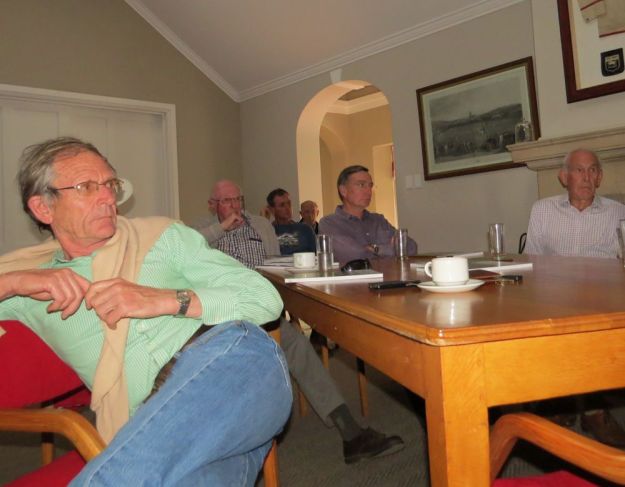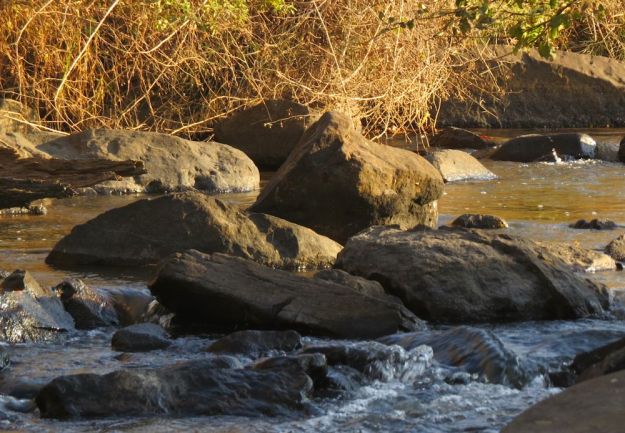Members of the Midlands Conservancies Forum gathered in Balgowan recently to explore Milestone Forest and learn more about the fate of the Mpofana River.
It was the ancient Yellowwoods of Milestone that inspired the first Conservancy in South Africa – formed right here. Walter Addison shared some of the history of how they came to be here (survivors of the last ice age) as we gazed in awe at the giant trees that form the ‘Cathedral’.
 Balgowan Conservancy hosts a guided walk in this forest on the first Friday of each month. It is well worth a visit. Contact Marilyn on 082 427 3365 to book.
Balgowan Conservancy hosts a guided walk in this forest on the first Friday of each month. It is well worth a visit. Contact Marilyn on 082 427 3365 to book.
As we drove back to Michaelhouse we passed the spot where the water release/outfall from the new Spring Grove Dam will enter the Mpofana river. We had invited Kate Fenenga of TCTA to address our meeting on the impacts the Spring Grove water release will have on the Mpofana, but she was not able to unless we submitted all the questions we might ask beforehand.
Instead we had Kevin Meier from Umgeni Water share their operating philosophy of Spring Grove Dam. This was really interesting.
He told us that the uMngeni river catchment is now completely utilized and that we cannot build any more dams on these rivers. Their job is to supply water to the municipalities. They pump as much as possible to keep Midmar and Albert Falls dams full and watch the weather closely to stop pumping when rain is imminent.
Obviously, we were most concerned about the impact of more water on the Mpofana river as the Mooi Mearns Transfer Scheme (MMTS) had already had a negative impact according to some of the landowners present.
Kevin said “We believe we can release 4,5 cubic metres per second without impacting the environment.” Currently they transfer 3,5 m3 in the wet season (about 3 months of the year). Once the new pipeline is in they will increase transfer to maintain continuous minimum flow of 4,5m3 although pipe capacity is 5,4m3. The thinking is that the river will adjust from minimal basal flow to 4,5m3 over the first year or two of operation. We were aghast to hear that this release will continue throughout winter when the normal river only has about 1 cubic metre per second of water. No doubt this will impact negatively on the health of the river.
Balgowan Conservancy members whose properties have already been affected by the raised levels of water in the Mpofana (from the Mooi Mearns Transfer Scheme) asked questions about their causeways, river banks and bridges. Kevin suggested that most of these concerns needed to be addressed by DWAF, not Umgeni Water. Apparently the Dept of Water Affairs is about to conduct a survey of the entire Mpofana and Lion’s rivers. It appears that their main focus is on erosion of the river banks, not the ecological health of the riparian zone. They assume that the river will realign itself. SASS surveys will be conducted four times a year above and below the outfall to monitor the impact.
Kevan Zunckel was up next. Kevan has done extensive research the negative affect of dams in general and the importance of keeping our rivers intact and shared some fascinating information with us, relating to the points Kevin Meier had raised.
It is currently costing Durban R100 million to treat water – Durban’s current water treatment bill is approximately R100 million per month and based on the findings of the uMngeni River Walk where the water quality improved from extremely poor to natural below the Albert Falls Dam as a result of riparian vegetation restoration, it can be calculated that it will cost 10% of the monthly water treatment spend to replicate this restoration work along the entire length of the uMngeni River’s main stem. This would lead to the creation of hundreds of jobs and a reduction in the treatment costs.
Both the Lion’s and Mpofana rivers do an excellent job of assimilating impurities. These tributaries are highly sinuous, i.e. they meander extensively, with associated flood plains and oxbows. This gives them the potential to assimilate both sediments and impurities as the actual length of the channels is significantly longer than the direct distance between a source of pollution and Midmar dam (as the crow flies).
The nutrification of the big dams – this would be “eutrophication”, i.e. the artificial or accelerated increase in nutrients coming from intensive agriculture. We know that the Lions is not in good condition and has a dense concentration of intensive crop and animal production activities along its banks and in the catchment, and now that the MMTS-2 is coming on ‘stream’, the added impurities from the Mooi system will exacerbate this situation. Although Umgeni Water’s water quality monitoring suggests that the Mooi and Lions are in pretty good shape, it is possible that with a little more intensive monitoring a different picture will emerge. Penny’s walk of the Lions showed this to be true. Without the MMTS-2 I have been told that the prediction for Midmar’s eutrophication to similar levels as Hartebeespoort Dam, was between 15 – 20 years. Now with the MMTS-2 adding to the system, it is predicted that this may happen in 10 to 15 years. Inanda is already showing signs of algal blooms in the upper and mid sections, but its depth and convoluted shape allows for this to be dealt with by the time it gets to the lower end where the raw water is abstracted. So it is not a water quality and treatment problem as yet, but in drier years when the concentration increases, it could well reach the threshold from which it tips across to the Hartebeespoort type of situation.
Ecological infrastructure has the capacity to do wonderful things with our messes, but if we push the systems too far, then we will exceed this capacity and lose the ecological services. Intensive agriculture can work with ecological infrastructure if it recognises the value of the services and respects the thresholds, otherwise that is when the R100 million/month bills begin to emerge.
It turned out to be a truly interesting afternoon, with plenty of food for thought. MCF has raised funds (from N3TC) for the DUCT River Walkers to explore the Mpofana this month, Balgowan Conservancy is helping with the organisation and generously providing accommodation. Follow the journey on their blog: www.umngeniriverwalk.wordpress.com
As we left, a Spotted Eagle Owl nest with a couple of chicks was pointed out to us in the car park – beside the busy rugby field! Despite the handy ledge that was built especially for them, the noise must have annoyed them after a while – or perhaps the heated debate at the MCG gathering was the final straw? They have now all moved to the Rectory garden where they are thriving. Nature certainly is resilient and adaptable, but as Kevan Zunckel said – it is about thresholds, sometimes we push Nature too far. Then we will all suffer.









Fascinating Report; very valuable communication. Many thanks. I look forward to the day when the topic becomes desalinization plants. Certainly they uses masses of power, but surely power which is paid for and enables potable water for the demanding masses is every bit as important as power for all which is largesse. Time will tell. And they’d give our pressurized rivers a breather Just a little of that money to be spent on atomic power stations – diverted to a another useful purpose .
LikeLike
Pingback: Mpofana – The River that Went | River Walks